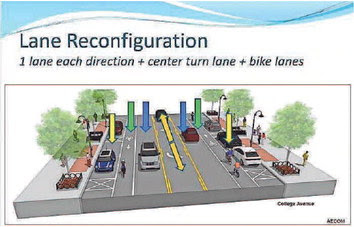Duke Behnke | Appleton Post-Crescent USA TODAY NETWORK – WISCONSIN
APPLETON – The Municipal Services Committee recommended Monday that Appleton proceed with the reconfiguration of College Avenue from a four-lane street to a three-lane street in an effort to improve function and safety.
The committee vote was 4-0. The proposal will be considered by the Common Council on April 5.
The reconfiguration would be done as an 18-month pilot project, allowing the city to evaluate the results before deciding to make the change permanent.
What would change, and how much would it cost?
The change from four lanes to three lanes, known as a road diet, would affect College Avenue between Richmond Street/Memorial Drive and Drew Street.
College Avenue currently has two lanes of travel in each direction, plus onstreet parking on each side.
Under the pilot, the street would have one lane of travel in each direction and a center left-turn lane at each intersection between State Street and Drew. That would create space to add a bicycle lane in each direction. The on-street parking would remain unchanged.
The city budgeted $130,000 for the conversion. It would entail repainting the lane markings and making adjustments to traffic signals.
What’s wrong with the current setup?
Mayor Jake Woodford said speeding, traffic noise and pedestrian safety within the College Avenue business corridor have generated numerous complaints from residents, business owners and visitors since he took office in 2020.
He challenged staff to find a better alternative. After a year of study, traffic engineers recommended the road diet.
Prior to that, Appleton took steps to improve the conditions on College, adding amenity strips, enhanced crosswalk pavement markings, early walk signals, midblock crossings and heightened police patrol and enforcement.
“While these efforts have likely mitigated some negative effects of the increased traffic and speed, there remains a desire to calm the corridor and create a comfortable environment for all users,” Public Works Director Danielle Block said.
How would the road diet help?
Traffic engineers said the road diet would offer the following advantages:
- Reduction in crashes by 19% to 47%.
- Improved left-turn safety due to better sight lines and dedicated leftturn arrows.
- Improved traffic flow, as drivers no longer would get stuck behind someone making a left turn.
- Reduced speeding and thus reduced traffic noise. Drivers no longer would be able to weave through two lanes of traffic.
- Elimination of drag racing.
- Reduction in pedestrian crashes by as much as 80%.
- Addition of dedicated bike lanes for bicyclists and operators of Bird scooters, keeping them off the sidewalks.
What are the drawbacks of the road diet?
One disadvantage would be more traffic congestion during peak periods. It typically takes five minutes to drive between Richmond/Memorial and Meade Street. According to modeling, the change would add about one minute of drive time in the morning and three minutes of drive time in the afternoon for motorists going from one end to the other.
City traffic engineer Eric Lom said drivers who experience the longer drive times and find it intolerable likely will “do a calculation in their head and say, ‘Is this still the best route for me at this exact moment?’”Franklin and Lawrence streets, which run parallel to College, have additional capacity to handle motorists who choose to bypass College.
In addition, critics contend that with only one driving lane, traffic will back up while waiting for someone to parallel park. Engineers said the design will allow the motorist who is parallel parking to temporarily occupy the bicycle lane, so the trailing motorists will have sufficient space to pass without leaving the driving lane.
When would the change occur?
If the reconfiguration is approved by the council in April, city staff will solicit bids for the work, which would be brought back for approval by the committee and council in April or May.
The repainting of the lane markings would be done during a two-week period in the summer, depending upon weather. Signal improvements and modifications would occur in late summer and fall.
Data collection and traffic monitoring would follow and be reported to the Municipal Services Committee. The pilot project would be evaluated in the spring of 2025.
Contact Duke Behnke at 920-9937176 or dbehnke@gannett.com. Follow him on Twitter at @DukeBehnke.


